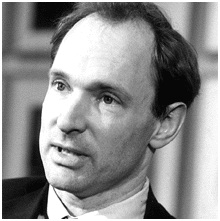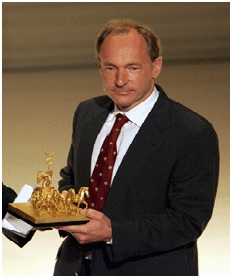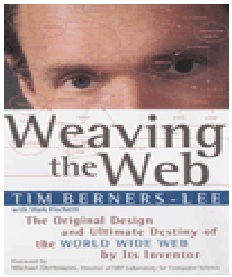Tim Berners Lee

Sir Timothy John "Tim" Berners-Lee, born in 8 June 1955 at London. He is also known as "TimBL". He is a British computer scientist, MIT professor and the inventor of the World Wide Web. Tim Berners-Lee's mother and father were mathematicians who were part of the team that programmed Manchester University's Mark I, the world's first commercial, stored program computer, sold by Ferranti Ltd. From an early age, he was fascinated by both mathematics and electronics. As a schoolboy, he closely followed the emerging field of transistor technology and built electronic devices to control his model trains. One day when he was in high school Berners-Lee found his dad writing a speech on computers for Basil de Ferranti. Father and son talked about how the human brain has a unique advantage over computers, since it can connect concepts that aren't already associated. Young Berners-Lee was left with a powerful impression of the potential for computers to be able to link any two pieces of previously unrelated information. Berners-Lee graduated from Queen's College at Oxford University in 1976 with a degree in physics. He then worked for two years as a software engineer with Plessey Telecommunications on distributed systems, message relays, and bar coding. He then joined D.G. Nash, where he developed a multi-tasking operating system, and typesetting software for intelligent printers. CERN. In 1980, Berners-Lee first started work as a consultant at CERN, originally called the Conseil Européen pour la Recherche Nucleaire, and now the European Particle Physics Laboratory, but still called CERN for old time's sake.

At CERN, Berners-Lee was faced with the daunting task of correlating the sprawling body of research carried out by separate teams, all documenting their work on disparate, incompatible systems. For his own convenience, he devised a software application he called Enquire, based on the concept of "hypertext," which allowed him to link documents on the basis of single-word associations, rather than through the branching hierarchies of existing systems. Berners-Lee urged his associates at CERN to try Enquire, but found few takers. From 1981 to 1984, Berners-Lee left CERN and worked at Image Computer Systems as Technical Design Lead, with responsibility for real-time, graphics, and communications software for an innovative software program that enabled older dot-matrix printers to print a wide range of advanced graphics. By 1989, CERN was already home to the largest Internet node in Europe, but finding information over the Internet was no easy task. Requests for information had to be sent from one user to another, and replied to individually. Distributing messages to a group, and collecting their feedback, created long documents, with relevant information buried under a blizzard of queries, addresses and replies. Berners-Lee imagined combining the Internet with linked hypertext documents, to provide access to an open-ended body of interactive information.

In March 1989, Berners-Lee proposed a global hypertext project, one that would permit researchers all over the world to share work-in-progress, transmitted instantaneously, without the delays associated with traditional publication or cumbersome mail groups. With collaborators at CERN, Berners-Lee wrote the "hypertext transfer protocol" (HTTP) for transmitting documents over the Internet. HTPP protocol standardizes communication between web servers, where documents are stored, and the client programs, or browsers, used to view them. He also originated a system of identifying documents, originally known as the universal resource indicator, now known as the universal resource locator (URL). He devised the hypertext markup language (HTML) for formatting web documents, and programmed the first web server to store and transmits them. To make the proposed network visible to the end user, he created the first web browser, an application for both viewing and editing the documents online, which he named World Wide Web. He made the entire system available within CERN in October 1990. At first, his invention attracted little notice. On August 6, 1991, he opened his web site (info.cern.ch) to public access over the Internet. He posted instructions for how to set up web servers and create sites, providing all the software he had created, free of charge. He announced his creation through a few Internet mail groups. Word of his invention spread quickly through the international community of computer enthusiasts, who soon set up servers and built web sites of their own. When they sent word of their work to Berners-Lee, he quickly provided links to their sites on his own. With input from an ad hoc army of volunteer collaborators around the world, he continually refined his specifications.
 The World Wide Web made it possible, not only to link text documents, but to download software and provide access to artwork, photography, audio and video files.
Timothy Berners-Lee recounted the story of the birth of the web, along with his thoughts on its future, in his 1999 book “Weaving the Web”. He has received numerous awards and honors for his contribution to civilization.
Sir Timothy, his wife Nancy, and their two children make their home in Lexington, Massachusetts.
Sir Timothy Berners-Lee remains a leading international advocate of "net neutrality," preserving the open nature of the World Wide Web.
The World Wide Web made it possible, not only to link text documents, but to download software and provide access to artwork, photography, audio and video files.
Timothy Berners-Lee recounted the story of the birth of the web, along with his thoughts on its future, in his 1999 book “Weaving the Web”. He has received numerous awards and honors for his contribution to civilization.
Sir Timothy, his wife Nancy, and their two children make their home in Lexington, Massachusetts.
Sir Timothy Berners-Lee remains a leading international advocate of "net neutrality," preserving the open nature of the World Wide Web.
References:-
www.w3.org/People/Berners-Lee/Longer.html
www.ibiblio.org/pioneers/lee.html
www.wekipedia.com
www.biographycentral.net/tim-bernerslee.php
www.achievement.org/autodoc/page/ber1bio-1
